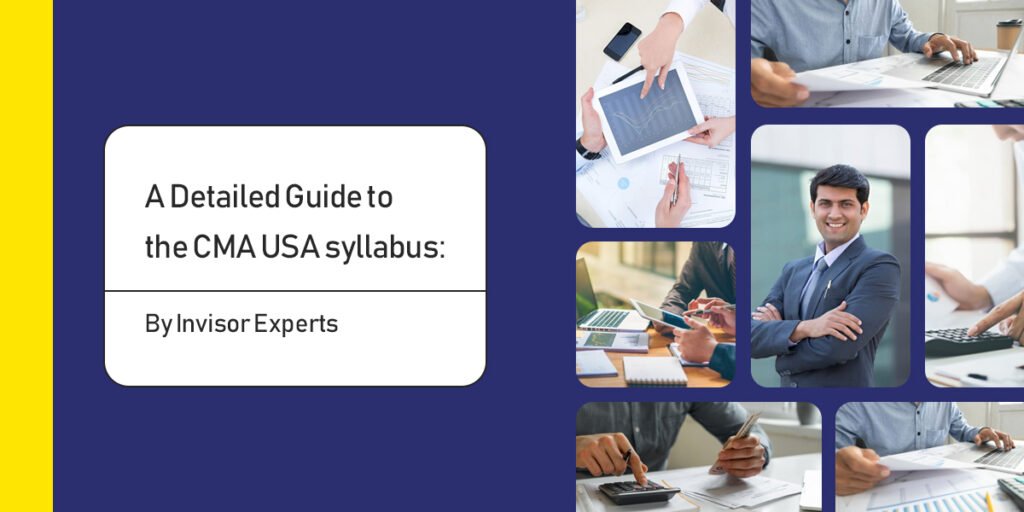A Detailed Guide to the CMA USA Syllabus: By Invisor Experts

Introduction CMA USA Syllabus
The Certified Management Accountant (CMA) USA designation is one of the most respected and globally recognized accounting credentials. Earning your CMA USA certification requires passing two exams, which cover a broad range of topics in management accounting. In this article, we’ll provide a detailed guide to the CMA USA syllabus so that you can better understand what to expect on the exam.
CMA USA Syllabus: An Overview

The Certified Management Accountant (CMA) USA syllabus is a comprehensive guide to the accounting and financial management knowledge and skills required to earn the CMA credential. The syllabus is organized into four key content areas: financial reporting, planning, analysis, and control; corporate finance; decision analysis; and financial statement analysis.
CMA USA Syllabus Exam Structure

The CMA USA exam is a two-part exam, with each part consisting of 100 multiple-choice questions as well as the two 30-minute essays. You will have four hours to complete each part of the exam.
The first part of the exam covers financial reporting, planning, performance, and control. The second part covers financial decision-making. To clear the exam you need to achieve a passing grade of 360 out of 500 points.
The registration for an exam is only valid for one exam window. If you wish to take the examination again, you have to register again. The testing window opens up three times a year, in the months of January/ February, May/ June, September/ October. You can book the slot of your choice and take the examination accordingly.
CMA USA Syllabus

Part 1 CMA USA Subjects: Financial Planning, Performance and Analytics
This section covers the basics of financial reporting and analysis, including an overview of the accounting cycle, financial statements, and ratios. You will also learn about the different types of financial statements and how to interpret them.
| Course | Weightage | Hours of study |
| External Financial Reporting Decisions | 15% | 40hrs |
| Planning, Budgeting, and Forecasting | 20% | 24hrs |
| Performance Management | 20% | 16hrs |
| Cost Management | 15% | 24hrs |
| Technology and Analytics | 15% | 12hrs |
| Internal Controls | 15% | 12hrs |
A- External Financial Reporting Decisions
1- Financial Statements
- Balance sheet
- Income statement
- Statement of changes in equity
- Statement of cash flows
- Integrated reporting
2- Recognition, Measurement, Valuation, and Disclosure
- Asset valuation
- Valuation of liabilities
- Equity transactions
- Revenue recognition
- Income measurement
- Divergence between U.S. GAAP and IFRS
B- Planning, Budgeting, and Forecasting
1- Strategic Planning
- Understanding the factors affecting strategy both external and internal factors
- Long-term mission and goals
- Alignment of tactics with long-term strategic goals
- Strategic planning models and analytical techniques
- Characteristics of a successful strategic planning process
2- Budgeting Concepts
- Operations and performance goals
- Characteristics of a successful budget process
- Resource allocation
- Other budgeting concepts
3- Forecasting Techniques
- Regression analysis
- Learning curve analysis
- Expected value
4- Budgeting Methodologies
- Annual business plans (master budgets)
- Project budgeting
- Activity-based budgeting
- Zero-based budgeting
- Continuous (rolling) budgets
- Flexible budgeting
5- Annual Profit Plan and Supporting Schedules
- Operational budgets
- Financial budgets
- Capital budgets
6- Top-level Planning and Analysis
- Pro forma income
- Financial statement projections
- Cash flow projections
C- Performance Management
1- Cost and Variance Measures
- Actual and projected results comparison
- Analyzing performance with variable budgets
- Exceptional management
- Standard costing systems are used
- Examining differences between actual cost estimates
2- Reporting Segments and Responsibility Centers
- Different kinds of responsibility centers
- Charges for transfers
- Organizational segment reporting
3- Performance Measurement
- Profitability study of a product
- Profitability study of business units
- Profitability study of customers
- Investment return
- Earnings on a long-term basis
- Problems with the investment base
- Indicators of performance (KPIs) Key Performers indicators.
- Balanced scorecard
D- Cost Management
1- Measurement Concepts
- Cost behavior and cost objects
- Actual and normal costs
- Standard costs
- Absorption (full) costing
- Variable (direct) costing
- Joint and by-product costing
2- Costing Systems
- Job order costing
- Process costing
- Activity-based costing
- Life-cycle costing
3- Overhead Costs
- Fixed and variable overhead expenses
- Plant-wide vs. departmental overhead
- Determination of allocation base
- Allocation of service department costs
3- Supply Chain Management
- Lean resource management tecMhniques
- Enterprise resource planning (ERP)
- Theory of Constraints
- Capacity management and analysis
4- Business Process Improvement
- Value chain analysis
- Value-added concepts
- Process analysis, redesign, and standardization
- Activity-based management
- Continuous improvement concepts
- Best practice analysis
- Cost of quality analysis
- Efficient accounting processes
E- Technology and Analytics
1- Information Systems
- Accounting information systems
- Enterprise resource planning systems
- Enterprise performance management systems
2- Data Governance
- Data policies and procedures
- Life cycle of data
- Controls against security breaches
3- Technology-Enabled Finance Transformation
- System development life cycle
- Process automation
- Innovative applications
4- Data Analytics
- Business intelligence
- Data mining
- Analytic tools
- Data visualization
F- Internal Controls
1- Risk, Compliance, and Governance
- Management philosophy and internal control structure
- Policies for safeguarding and ensuring information.
- Risk of internal control
- Corporate management
- Mandatory external au=dits
2- Controls and Security Measures for the System
- Accounting system controls in general
- Transaction and application controls
- Network management
- Controls for backups
- Continuity of operations planning
Part 2 CMA USA Subjects:- Strategic Financial Management
The strategic financial management part of the CMA USA syllabus covers a wide range of topics, from financial planning and forecasting to investment analysis and portfolio management. The coursework is designed to give students a thorough understanding of the financial management process, so that they can make sound decisions in a variety of business contexts.
| Course | Weightage | Hours of study |
| Financial Statement Analysis | 20% | 16 hrs |
| Corporate Finance | 20% | 30hrs |
| Decision Analysis | 25% | 15 hrs |
| Risk Management | 10% | 5hrs |
| Investment Decision | 10% | 7hrs |
| Professional Ethics | 15% | 9hrs |
A. Financial Statement Analysis
1- Basic Financial Statement Analysis
- Common size financial statements
- Common base year financial statements
2- Financial Ratios
- Liquidity
- Leverage
- Activity
- Profitability
- Market
3- Profitability Analysis
- Income measurement analysis
- Revenue analysis
- Cost of sales analysis
- Expense analysis
- Variation analysis
4- Special Issues
- Impact of foreign operations
- Effects of changing prices and inflation
- Impact of changes in accounting treatment
- Value and Income – Accounting and economic concepts
- Earnings quality
B- Corporate Finance
1- Risk and Return
- Return Calculation
- Different types of risk the link between risk and reward
2- Financial Planning for the Long Term
- Interest rate structure over time
- Different kinds of financial instruments
- Capital costs
- Financial instrument valuation
3- Capital Raising
- Regulation and financial markets
- Effectiveness of the market
- Financial establishments
- Initial public offers (IPOs) and secondary public offerings (IPOs)
- Share repurchases and dividend policy
- Leasing options
4- Management of Working Capital
- Terminology for working capital
- Managing cash flow
- Managing marketable securities
- Management of accounts receivable
- Inventory control
- Different kinds of short-term credit
- Managing short-term credit
5- Business Reorganization
- Acquisitions and mergers
- Restructuring in other ways
6- International Financial Services
- Exchange rates that are fixed, variable, and floating
- Dealing with transaction risk
- International trade financing
C- Decision Analysis
1- Cost/Volume/Profit Analysis
- Breakeven analysis
- Profit performance and alternative operating levels
- Analysis of multiple products
2- Marginal Analysis
- Opportunity costs, Sunk costs
- Marginal costs and marginal revenue
- Special orders and pricing
- Make vs. buy
- Sell or process further
- Add or drop a segment
- Capacity considerations
3- Pricing
- Pricing methodologies
- Target costing
- Elasticity of demand
- Product life-cycle considerations
- Market structure considerations
D. Risk Management
1- Enterprise Risk
- Types of risk
- Risk identification and assessment
- Risk mitigation strategies Managing risk
E- Investment Decisions
1- Capital Budgeting Procedure
- Capital budgeting stages
- Cash Flows in Steps
- Income-tax implications
- Assessing the level of uncertainty Methods of capital investment analysis
- Present value (NPV) • Return on investment (ROI) • Payback • Methods of investment analysis comparison
F – Professional Ethics
1- Business Ethics.
- Moral theories and values in business
- Making ethical decisions Financial professionals’ ethical considerations
- IMA’s Ethical Professional Practice Statement
- The triangle of deception
- Ethical issues are assessed and resolved.
2- Organizational Ethical Considerations
- Ethical culture and organizational factors
- The IMA’s declaration “Values and Ethics: From Inception to Practice.”
- Moral Leadership
- Legal observance
- Accountability for ethical behavior
- Social responsibility and sustainability
CMA USA Program Fees
Professional Members:
- Entrance fee: $ 250 (Non-Refundable)
- Exam fee: $ 415 per Part
Student/Academic Member:
- Entrance fee: $ 188 (Non-Refundable)
- Exam fee: $ 311 per Part
How to Study for the CMA USA Exam
- To study for the CMA USA exam, you should first become familiar with the exam content outline. This outline will give you an overview of the topics covered on the exam. Once you know what to expect, you can begin studying specific concepts and practicing with sample questions.
- There are many study resources available to help you prepare for the CMA USA exam. The Institute of Management Accountants (IMA) offers an official study guide, as well as online practice tests. In addition, there are many unofficial study guides and practice tests available online. Invisor provides the latest CMA US practice samples to study smarter and harder.
- When studying for an exam, it is important to create a study schedule and stick to it. Dedicate a specific amount of time each day or week to studying, and make sure to review material regularly. It is also a good idea to take practice exams under timed conditions to get used to the pacing of the exam.

The Bottom Line
The CMA exam is one of the most popular exams in the world and is the standard for measuring financial accounting knowledge. With so many details in the syllabus, we hope this post helped you understand how the CMA exam is organized and what topics are covered.

If you need help with the CMA exams, we have a detailed course on the CMA USA designed for finance professionals. We’ve broken down the syllabus into all the different sections and gone into detail about each section and the best way to pass every exam. We also offer a video course to help you prepare for the exams. Attend our free demo session and decide for yourself!
Don’t forget to check out Invisor’s other courses as well!
FAQS on CMA USA Syllabus
Is it possible for someone without experience to take the CMA exam?
Though anyone can take the Certified Management Accountant (CMA) exam, regardless of experience. However, it is recommended that candidates have at least two years of professional accounting experience before taking the exam. The CMA exam is a challenging exam that covers a wide range of topics, so having some experience in the field will help you to be better prepared.
Can I take the CMA exam online?
CMA candidates have the option of taking their exams either in person at a Prometric Test Center, or online using Prometric’s ProProcto service. Both options have their benefits, so it’s important to decide which one is right for you before scheduling your exam.
What is the recommended study time for the US CMA exam?
For each part of the US CMA exam, a minimum of 120 to 150 hours of study is required.
Is CMA USA easier than CA?
The difficulty of either the CMA USA or CA designation depends on the individual’s background and experience. However, some generalizations can be made. For starters, the CMA USA can be completed in as little as 18 months, while the CA designation typically takes 3-4 years to earn. In addition, the CMA USA focuses specifically on financial management and decision-making, while the CA covers a broader range of topics. As a result, many candidates find the CMA USA to be a more targeted and relevant credential.
How many attempts are there in CMA USA?
There is a maximum of three attempts allowed for US CMA candidates to pass the exam. A new application and application fee are required for each exam attempt.





